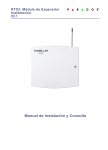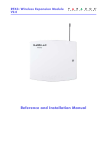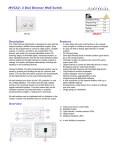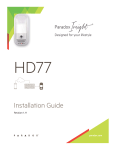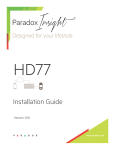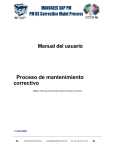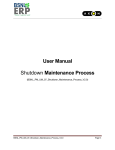Download LV8D : Reference and Installation Manual
Transcript
LV8D: 8 Output Low-Voltage Relay Module Description Features Driven by the V32 main controller’s 4-wire communication bus (Multibus), the LV8D has 8 solid-state relay outputs that can drive up to 250mA each @ 0 to 24V AC/DC. Each set of 4 relays has a jumper selectable power source that can be the 12Vdc Multibus power or an external 0-24Vac/dc power source. • • • • These outputs can be used to control external relays or to power low voltage devices, such as sprinkler valves, low voltage lights, door strikes, or devices equipped with a 24Vdc external trigger (e.g. air conditioners, thermostats, garage doors). When using an external 24Vac/dc power supply, the LV8D outputs can be used to drive 24Vac/dc relays. • • • TM Installation/Wiring: ?? Programming 1: ?? Programming 2: ?? Testing: ?? Total Time: ?? 8 solid-state relay outputs (0-24V AC/DC, 250mA each) Selectable relay power (internal 12V/external) Remote firmware upgradeability via bus DIN rail design with manual control for outputs, onboard status display, and removable terminals Programming via BabyWare software 4 wire connection to the Imperial Multibus with up to 900m (3000ft) distance Bi-directional Locate feature from module to software and vice versa With its DIN rail design, the module saves space, and makes installation and wiring significantly faster and easier. Overview A D 1 2 3 4 B C 1) Manual output control and status buttons 2) Module Locate feature activation (see "Bi-directional Locate Feature”) 3) Multibus status LEDs 4) Product serial number For LED status, see "LED Feedback”. A) Low-voltage relay outputs. B) 4-wire Multibus connection C) Trigger activation input (future use) D) Power configuration jumpers (see "Wiring”) For items A to E, refer to "Wiring”. Related Topics Specifications Installation / Wiring (refer to the Imperial System Guide) • DIN Rail Enclosures • System Diagrams and Wiring Tips • Wire Gauge Selection Operating voltage Typically 12Vdc Relay voltage range 0 - 24Vac/dc Relay maximum continuous current per output 500mA Current Consumption min. 30mA max. 120mA Dimensions DIN9: 11cm X 10cm X 6cm (4.2” X 4” X 2.5”) Operating Temperature -10ºC to 50ºC 14ºF to 122ºF Features • Remote Firmware Upgrade • Bi-directional Locate Feature Applications (refer to the Imperial System Guide) • Light Control • Sprinklers • Macros BabyWare (refer to the Imperial System Guide) • BabyWare Wiring To use the LV8D’s internal 12Vdc power source, connect the C1 (relays 1-4) and/or C2 (relays 5-8) jumpers. To use external power, disconnect the jumpers and connect the external power source as shown in the wiring diagrams. Internal Power The LV8D’s 12Vdc Multibus supply can be used to control external relays or to power low voltage devices e.g. sprinkler valves, low voltage lights, door strikes. Certain devices e.g. air conditioners, thermostats, garage doors may be equipped with an external trigger. Triggers requiring 12Vdc and less than 100mA can be driven directly from the LV8D output using 12Vdc Multibus power. For all other requirements e.g. current higher than 100mA or different voltage, use an external power supply. External Power The LV8D outputs can be used to drive 24Vac/dc relays when connected to an external 24Vac/dc power supply. WARNING: Do not supply external power to C1 if C1 jumper is on. Do not supply external power to C2 if C1 jumper and C2 jumper are on. WARNING: It is highly recommended to power the module using an external source (e.g. PS100 or PS27D) and NOT from the Multibus to avoid flickering of the output in case of a loss of bus power. Flickering may cause damage to electrical appliances connected to the outputs. C1 C2 Mode ON ON In this configuration, all outputs use Multibus power. • Maximum combined current for all 8 outputs = 1A (according to available Multibus power) 12Vdc Multibus Power Wiring Diagram C1 C1 C2 C2 ON ON - + 12Vdc Relay C1 STATE C1 ON BUS INPUT Imperial Multibus C2 STATE C2 ON - + 12Vdc Relay C1 C2 Mode ON OFF In this configuration, C1 uses Multibus power; C2 uses an external power supply. • Maximum combined current for outputs 1 to 4 = 1A (according to available Multibus power) • Maximum combined current for outputs 5 to 8 = 2A 12Vdc Multibus Power Wiring Diagram C1 C1 C2 C2 ON OFF - + 24Vdc Power Supply 24Vdc Relay Imperial Multibus In this configuration, all outputs use the C1 power supply. • Maximum combined current for all 8 outputs = 2A 0-24Vac/dc External Power C2 OFF - + C2 STATE + C1 ON BUS INPUT 0-24Vac/dc External Power OFF ON C1 STATE 12Vdc Relay C1 C1 C2 C2 OFF ON - + + - 24Vdc Power Supply 24Vdc Relay C1 STATE C1 OFF C2 STATE - + 24Vdc Relay C2 ON BUS INPUT Imperial Multibus OFF OFF In this configuration, both C1 and C2 terminals use external power supplies. • Maximum combined current for outputs 1 to 4 = 2A • Maximum combined current for outputs 5 to 8 = 2A 0-24Vac/dc External Power C1 C1 C2 C2 OFF OFF + + 24Vdc Power Supply - 24Vdc Relay ~ C2 STATE ~ C1 OFF BUS INPUT 0-24Vac/dc External Power Imperial Multibus C2 OFF ~ 24Vac Power Supply 24Vac Relay ~ LED Feedback BUS Red on Red flash Blue flash RX Green flash - TX Green flash - - Green on Green on Green flash - Green on Green flash - STATUS OK (communication in progress) Com fail: short on GRN or YEL Com fail: too many modules Com fail: GRN and YEL lines reversed Bus power too low Module locate mode 1 OUTPUTS 1 to 8 Press to activate/deactivate Green On = Output activated Off = Output deactivated BUS INPUT Firmware upgrade in progress Bi-directional Locate Feature Pressing and holding the LOC button for 3 seconds will initiate the Module Locate feature. When a Module Locate is initiated, the module’s representation in the BabyWare software will flash and the module’s BUS, RX and TX LEDs will flash to indicate that it is in locate mode. A module locate can also be initiated from the BabyWare software. From BabyWare right-click the module’s representation and select Locate Physical. The module’s BUS, RX and TX LEDs will flash. We highly recommend that after pressing locate and identifying the module, open the programming page and assign the proper physical location label and the outputs’ labels and locations. After complete connection, use the space provided on the module to indicate the outputs’ description. Remote Firmware Upgrade The LV8D is firmware upgradeable remotely via the V32 controller’s Multibus at 57.6Kbps. Using BabyWare connect to the V32 account using any of the connection methods (direct connect, IP static, or IP DNS). Right-click the desired module and select Upgrade. A firmware upgrade for a single module or group of modules will take usually less than 10 minutes, which keeps system downtime to a minimum. Programming an LV8D Module Figure 16: LV8D Programming For more information on programming modules, refer to “BabyWare ” in the Imperial System Guide. 1) When BabyWare is communicating with the V32 controller and a LV8D module is connected to the Multibus, it automatically appears in the Modules display area. To view the Modules display area, click the Modules toggle button. Alternatively, you may wish to add a module to BabyWare before the module is physically connected to the system. Click the Add Item button. 2) To program a module that has already appears in the system, doubleclick the module’s icon. The Relay Controller Properties window opens. 3) From the Type drop-down list, select Sprinkler, Light, or Custom relay mode . 4) Label the outputs and set required activation/deactivation delays. Related Topics If you have trouble locating the module in BabyWare, you can use the Module Locate Feature (see "Bi-directional Locate Feature"). Patents: One or more of the following US patents may apply: 7046142, 6215399, 6111256, 6104319, 5920259, 5886632, 5721542, 5287111, 5119069, 5077549 and RE39406 and other pending patents may apply. Canadian and international patents may also apply. Trademarks: Paradox Imperial, MAMA, BabyWare, the M logo, and the triangle logo are trademarks or registered trademarks of Paradox Security Systems Ltd. or its affiliates in Canada, the United States and/or other countries. Certification: For the latest information on products approvals, such as UL and CE, please visit www.paradox.com. Warranty: For complete warranty information on this product please refer to the Limited Warranty Statement found on the website www.paradox.com/ terms. Your use of the Paradox product signifies your acceptance of all warranty terms and conditions. © 2009 Paradox Security Systems Ltd. All rights reserved. Specifications may change without prior notice. PARADOX.COM Printed in Canada - 04/2009 ILV8-EI01





